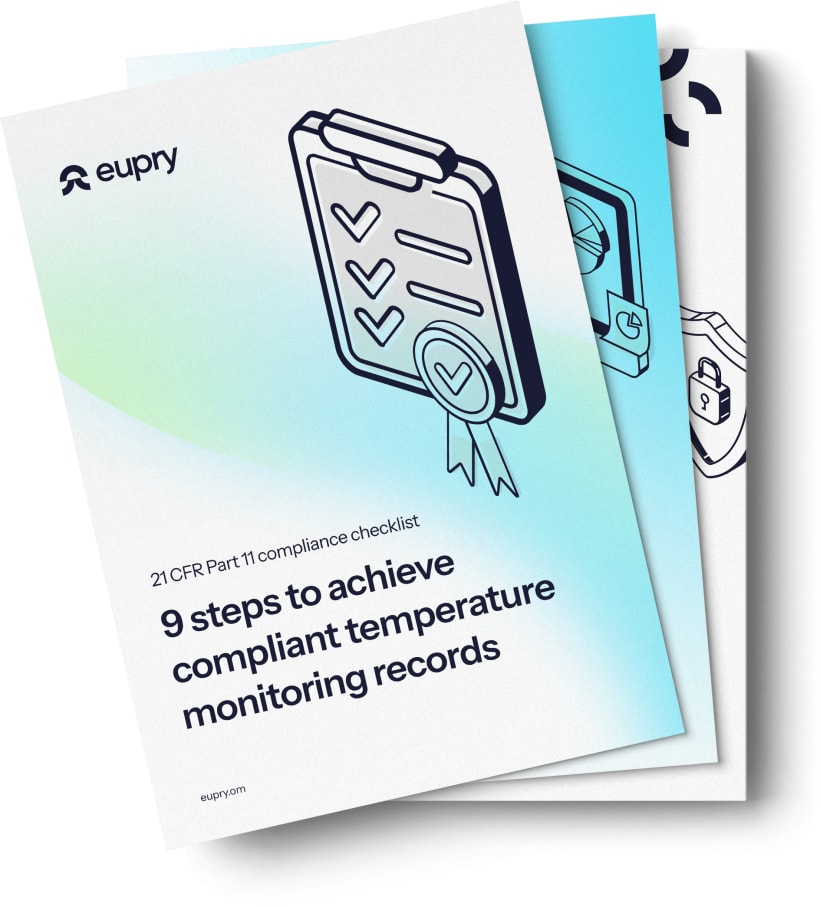
9 questions: Ensuring FDA 21 CFR Part 11 compliant temperature monitoring in pharma

Jakob Konradsen

Estimated reading time: 6 minutes
Dive into key aspects and guidelines of 21 CFR Part 11 compliance for pharmaceuticals and the steps you need to maintain compliant temperature records, systems, and processes that meet requirements.
When you work in pharma, biotech, or another highly-regulated industry you have undoubtedly come across FDA 21 CFR Part 11.
Navigating the complexities of 21 CFR Part 11 compliance can seem daunting, especially when the integrity of your temperature compliance - monitoring, mapping, and calibration - processes is on the line.
However, understanding the regulation's scope, its relevance across global markets, and the types of records and electronic signatures it governs is the first step toward ensuring your operations meet FDA standards.
In this article, we break down the pivotal elements of FDA 21 CFR Part 11 you need to know to make sure your temperature compliance records and procedures live up to the standard.
Note: This paper gives an introduction to the 21 CFR Part 11 as interpreted by Eupry ApS and should not be considered an exact description of the regulations set forth by the FDA. The exact guidance on compliance with the regulation can be found here.
In this article, you can dive into:
- What is 21 CFR Part 11?
- Why is it based on handwritten records?
- Which organizations are the standard relevant for?
- Why is 21 CFR Part 11 not just relevant in the US?
- What type of records does 21 CFR Part 11 apply to?
- What are some examples of these record types in Pharma?
- What sections does 21 CFR Part 11 contain?
- What are the 21 CFR Part 11 guidelines you should follow to be compliant?
- What are the 21 CFR Part 11 requirements for electronic signatures?

Is your monitoring setup preventing compliance?
Check out the article: “21 CFR Part 11 compliant monitoring systems: What to look for?”
Questions and answers about 21 CFR Part 11 for temperature monitoring
What is 21 CFR Part 11?
21 CFR Part 11 is a regulation established by the U.S. Food and Drug Administration (FDA) to ensure the integrity, authenticity, and reliability of electronic records and signatures in regulated industries, such as pharmaceuticals and biotech.
The regulation aims to ensure that electronic records can be trusted in the same way that handwritten records and subsequent signatures on paper are trusted. The standard says that electronic records should be “equivalent to paper records and handwritten signatures executed on paper”1. In other words, it aims at ensuring the trustworthiness of digital records by treating them as equivalent to written records.
In relation to temperature compliance, the standard provides guidance relevant to environmental monitoring that can help ensure that temperature and other digital records are accurate, reliable, and secure.
Why is 21 CFR Part 11 based on handwritten records?
The historical context is that the standard originated in the 90s when the FDA recognized the increasing use of digital systems.
At the time, the baseline was handwritten records, and as a result, the standard is based on the understanding that the golden standard for security and reliability must be paper.
If a standard was created today, it would likely be based on digital as the ideal, and handwritten as the deviation.
But here we are.
Which organizations are 21 CFR Part 11 relevant for?
FDA 21 CFR Part 11 is relevant and applies to organizations operating in FDA-regulated industries such as pharmaceuticals, biotechnology, and medical devices that utilizes certain types of digital records – more on that in a second.
Why is 21 CFR Part 11 NOT just relevant in the US?
Even though it is an FDA requirement, 21 CFR Part 11 applies to organizations worldwide – not just in the United States.
If your organization is based outside the US and does not directly distribute products or operate within the US, it is not legally required to comply with FDA regulations.
However, if your organization exports products to the US or has business relationships with US-based companies that are subject to FDA regulations, you might need to demonstrate compliance with relevant regulations.

Tip! Even if you are not obligated to comply with 21 CFR Part 11 (yet), implementing procedures that demonstrate compliance with recognized international standards will not only help you secure the quality of your product but also enhance your credibility and marketability on an international level.

9 step 21 CFR Part 11 guidelines PDF
Make sure your temperature records live up to 21 CFR Part 11 requirements by following these steps.
What type of records does 21 CFR Part 11 apply to?
All records that are used for regulatory purposes, which are to be FDA compliant, should comply with the 21 CFR Part 11, with some small exceptions.
In other words, not all entries and records in a digital system have to be compliant with the regulation – so let us talk about the ones that generally do:
- Electronic records that are required to be maintained under predicate rule
- Records in electronic format in addition to a paper format that are relied on to perform regulated activities
- Records submitted to the FDA under predicate rules
- Electronic signatures that are intended to be the equivalent of handwritten signatures, initials, and other general signings required by predicate rules
It is up to an organization to prove that it complies with the regulation, and if it can do so the FDA will accept the use of electronic records instead of paper records. This can be done via validation of the system, either by the organization itself or with the help of an electronic system provider.
Also read: 21 CFR Part 11 compliant monitoring systems: What to look for?
What are some examples of these record types in Pharma?
Here are six examples of records that typically need to comply with 21 CFR Part 11 requirements:
- Batch records: Electronic records that document the manufacturing processes and controls for each batch of a product. These records include information about raw materials, equipment used, process parameters, and quality control tests such as temperature and humidity monitoring.
- Laboratory data: Digital records generated in pharmaceutical laboratories, including analytical data, test results, laboratory notebooks, and instrument readings.
- Quality control (QC) records: Records that pertain to quality control activities, such as calibration records, instrument logbooks, stability testing data, and batch release documentation.
- Complaint files: Electronic records that capture and track customer complaints, investigations, and corrective actions. This ensures the traceability and integrity of complaint-handling processes.
- Training records: Electronic records related to training programs, including training materials, attendance records, and competency assessments.
- Standard Operating Procedures (SOPs): Records related to the creation, revision, and distribution of SOPs that are maintained in digital form.
Note that the specific records subject to Part 11 requirements can vary depending on your organization, the nature of the products, and the processes involved.
Also see: Guidelines: Pharmaceutical refrigerator monitoring

Video guide: Guidelines for FDA 21 CFR Part 11-compliant monitoring and mapping
A step-by-step guide to keeping your temperature compliance processes and records up to standard.
What are the 21 CFR Part 11 guidelines you should follow to be compliant?
This section deals with how electronic records are controlled in closed systems, and under this also how records are ensured to be authentic including system access and audit trails.
These are some of the key requirements of 21 CFR Part 11:
- Validation: That data in a system is valid and that it can be trusted.
- Protection of records: Ensuring that documents are accurate and available in the retention period.
- Security measures: Your systems should be secure and protected – this includes several aspects such as user control, authentication, and ensuring data integrity. Your user authentication mechanisms could include the use of passwords, biometric authentication, or multi-factor authentication.
- Audit trails: Traceability is key. The system must be able to ensure secure records, with time-stamped audit trails with operator entries, whilst still ensuring that changes do not obscure original records. Clear audit trails are used to track changes made to the data. It must be clear which user made changes, and the date records were created, modified, deleted, etc.
- Ensure data integrity: Protect against unauthorized access, data loss (back up your data), and tampering.
- Personal accountability: Each person must be personally accountable for their actions, and their signatures should manifest their identity and purpose. In other words, it must be ensured that a user in the system is a real, accountable person, that has been approved for the specific role.
- Uniqueness and authenticity of users: Users should be unique individuals, and measures should be in place to ensure their authenticity. The system must ensure that only approved users are verified for the system.
- Process documentation and review: Document and frequently review your procedures.
- Training: Regularly train relevant personnel to ensure compliant use of your temperature monitoring system.
What sections does 21 CFR Part 11 contain?
This section will give a brief overview of the different sections in the 21 CFR Part 11, and the subsequent requirements in broad terms.
The regulation is divided into different sections which concern different requirements. The specific requirements and Eupry's compliance with these requirements are listed in the 21 CFR Part 11 compliance report by Eupry ApS, and the specific requirements can be found on FDA’s homepage.
Also read: 21 CFR Part 11 compliant monitoring systems: What to look for?
Implementation
The concerns of this section how electronic records can be implemented and accepted by the FDA. In broad terms, the FDA must be able to accept the digital format, and an organization must be able to prove that the electronic records comply with 21 CFR Part 11.
Regulations
This sections holds a series of definitions used for defining the type of system that is used, and the definition of a signature.
The most important part has to do with whether a system is closed or open. As an example, Eupry’s temperature compliance system is considered closed, as the user access is controlled by the same people who are responsible for its contents. In other words, the people who put in records and sign the content can control the user access themselves.
What are the 21 CFR Part 11 requirements for electronic signatures?
It is a requirement that a signature connected to a record, and that the identity of a user has been verified.
Furthermore, an organization must inform the FDA that it intends to use electronic signatures as legally binding.
There are a set of requirements for electronic signatures, which also include a requirement for passwords and/or PIN codes for each digital signature.
Digital signatures must also only be used by one person, and cannot be shared amongst several individuals.

9 steps to FDA 21 CFR Part 11-compliant temperature records
Ensure compliance of your temperature records with a “21 CFR part 11 compliance checklist”.
Summing up: Ensuring 21 CFR Part 11 compliance for your temperature monitoring setup
Compliance is not just a regulatory requirement; it is a commitment to quality, safety, and reliability in the pharmaceutical and biotechnology industries. By adopting systems and practices that align with 21 CFR Part 11, your organization can not only avoid regulatory pitfalls but also enhance its operational efficiency and credibility in the global marketplace.
As you move forward, consider leveraging digital solutions designed to simplify compliance easier.
Because compliance should not be hard. This is the foundation of Eupry. Our approach to temperature monitoring, mapping, and calibration is designed to make compliance a non-issue, allowing you to focus on what you do best.
Learn more
For more guidance on making your temperature monitoring systems compliant and ensuring your temperature compliance measures are up to standard — or to learn how Eupry can simplify your compliance journey, book a short talk with one of our compliance specialists or download a solution catalog today.
FAQ about FDA 21 CFR Part 11
Often asked questions - and their answers - about the FDA's 21 CFR Part 11 regulation.

